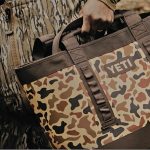Sportsman’s Warehouse Holdings Inc. reported a slightly larger operating loss on an adjusted basis in the the first quarter ended ended May 3, but comp sales grew for the first time in nearly four years as the company focused on replenishing in-store stock, which boosted sales in the Hunting, Fishing and Shooting Sports categories.
Company CEO Paul Stone stated on a conference call with analysts that rebuilding the foundation as a leading outdoor retailer hinges on disciplined execution across four key areas:
- Inventory Precision. Ensuring they “win the seasons” by being narrow and deep in hunting and fishing to improve in-stock levels in the 20 percent of key products that drive 80 percent of sales;
- Local Relevance. Empowering the retailer’s store outfitters employees to leverage their deep expertise and community connections to deliver the hyper local knowledge customers appreciate;
- Personal Protection. Establishing Sportsman’s Warehouse as the authority in personal and situational safety; and
- Brand Awareness. Reinvigorating the Sportsman’s Warehouse brand and engaging customers to establish the retailer’s position as the most convenient, trusted destination for outdoor gear and expertise.
“I’m proud of how our team executed against these key initiatives in Q1, delivering our first positive year-over-year sales comp in nearly four years,” Stone shared. “Despite ongoing consumer macroeconomic pressures and a later start to the spring selling season, first quarter sales were up 2 percent compared to last year.”
In Inventory, Stone said the company is well positioned with strong in stocks in key departments.
“In fact, sales were up while inventory was down in many core categories as we continue adapt and refine our assortment to meet the changing needs of the customer. We continue to build out bench strength in our merchandising group to further align our merch refinement strategy to the needs of the customer,” he noted.
“The improvement across our business was primarily driven by improved in-stocks on the key items, including depth in our top sellers, on time readiness within store merchandising and e-commerce channels for the early spring seasons, particularly with Fishing and a strategic shift to everyday low price on core ammo calibers and other consumables that drive in-store and online traffic, where we saw a 12 percent increase in ammo unit sales during the quarter,” Stone continued.
He said they were especially encouraged by our seasonal readiness and how far they have come in localizing merchandise assortments and geo targeting their marketing messages, using Alaska as an example where he said they were historically late to key seasons, but are now better aligned with local expectations, including depth and key items. He said it’s “showing in our results.”
Early in Q1, SPWH made the proactive decision with select vendors to pull forward spring and summer inventory in categories impacted by tariffs, particularly in Fishing and Camping.
“While this temporarily elevated our inventory levels, it ensures we are well stocked in our key goods heading into these peak selling seasons,” Sone said. “We’ll continue to apply this approach in Q2 to ensure we’re prepared for the critical hunting and holiday seasons. Importantly, we continue to anticipate ending the year with lower total inventory than last year and generating positive free cash flow.”
In Personal Protection, the CEO said they are making significant progress to stand as “the authority” in the business.
“We recently launched the Safety Outpost on our website, a curated experience focused on home defense and situational awareness. This signals our commitment to a major growth category that others have largely ignored, but our customers increasingly expect us to lead,” Stone shared. “To underscore our commitment, we recently launched a month-long campaign with Springfield, one of our top firearm brands in the personal protection space. In early May, we soft launched the less lethal side of our personal protection strategy with our partner Verna.”
Eleven stores now feature full shop-in-shops and 40 additional locations are said to have smaller tailored assortments. All locations offer live fire demonstration capabilities that result in significant conversion versus without trial, based on data from a test pilot program.
“The early results are encouraging and we see significant upside as we build out this program,” Stone noted.
Addressing Local Relevance and Brand Awareness, SPWH is also launching a new omni-channel brand campaign this quarter designed to reignite brand relevance and reestablish Sportsman’s Warehouse as the preferred destination for hunting, fishing and sports shooting adventures, “where great gear and great service meet trusted local expertise.”
Stone said the campaign is built to reengage former customers, build relationships with new ones and earn loyalty in a fragmented and competitive market. “Local is our competitive advantage, brought to life by passionate outfitters and the communities they serve,” he emphasized.
“Despite the ongoing consumer macroeconomic challenges, I remain confident in our strategic plan and the team’s ability to execute,” the CEO concluded. “Our unique competitive advantage lies in our ability to out-local to big boxes and out of sorts of small specialty retailers, delivering a compelling mix of value, quality, selection and locally centric personalized service. We are staying disciplined, managing what we can control, variable cost, inventory levels and merchandise margins.”
Fiscal First Quarter
Net sales increased 2.0 percent to $249.1 million, compared to $244.2 million in the first quarter of fiscal year 2024. The net sales increase was said to be primarily due to increased sales in the retailer’s Fishing, Hunting and Shooting Sports departments as the retailer continues the emphasis on core in-stocks and being locally and seasonally on-time with its merchandise.
“This marks a strong start to the year and reflects continued momentum from our improved Q4 performance,” said company CFO Jeff White. “Our positive comp sales underscore the early success of our strategic initiatives, specifically improved in stock levels across core categories and our refined omni-channel marketing strategy, which is driving more targeted customer engagement.
Asked about the comp trends by month, White said they saw good trends in February. He also explained that they had an ad shift that moved demand from March into April to be more in line with Easter and the start of summer.
“So March versus an LY comp was a little pressured by just some of the change in ad that we had, but April was really strong,” the CFO suggested. He said the trend has stayed strong into May into the warmer weather into the strong fishing season.
Stone reminded the call participants that Fishing was the first category the SPWH team addressed through its new merchandising strategy. “The two-year comp stack growth of 12.3 percent validates that when we get the right product in the right place at the right time and market in the right channel, the results follow,” he said.
Stone noted that Firearms unit sales “significantly outpaced” the adjusted NICS data (from NSSF), suggesting SPWH outsold the industry and continues to capture market share. Although the adjusted NICS declined 5.4 percent in Q1, the retailer’s firearm unit sales increased nearly 7 percent over last year. While firearm customers continue to trade down, AUR (average unit retail) for Q1 decreased 8 percent compared with last year.
“We’ve engineered our assortment to capture demand for value priced firearms and refined our accessory mix to drive basket growth and higher attachment rates,” Stone continued. “We also achieved positive sales comps in Q1 in most core categories, including Firearms, Clothing & Footwear, Ammunition – which was up 3 percent – and Fishing, which was up 11 percent.”
Camping sales were said to be down in Q1, but Stone said they believe this was largely due to the later spring and the timing of Easter.
The company’s e-commerce business also posted a positive comp in the quarter, increasing 8 percent year-over-year and outpacing the overall business.
“We are well positioned from an inventory standpoint with strong in stocks in our key departments,” he noted. “In fact, sales were up while inventory was down in many core categories as we continue adapt and refine our assortment to meet the changing needs of the customer. We continue to build out bench strength in our merchandising group to further align our merch refinement strategy to the needs of the customer.”
Profitability & Expenses
Gross profit was $75.6 million, or 30.4 percent of net sales, in the first quarter, compared to $73.8 million, or 30.2 percent of net sales, in the first quarter of fiscal year 2024. The increase as a percentage of net sales was said to be primarily driven by improved productivity of inventory and improved product margin rate in the Fishing category.
“This expansion was largely driven by favorable mix and rate improvements in our Fishing business, which carries a higher gross margin profile,” White noted. “That said, this gain was offset by increased freight expense tied to our strategic inventory pull forward in anticipation of higher tariffs and changes to international trade policy and to ensure we were fully stocked for the key spring and summer selling seasons.”
He said the move resulted in an estimated 50 basis-point drag on margin in the quarter, an intentional trade off that positions SPWH to “deliver better full price sell through during peak selling seasons.”
Selling, general, and administrative (SG&A) expenses were $95.3 million, or 38.2 percent of net sales, in Q1, compared to $94.4 million, or 38.6 percent of net sales, in the fiscal 2024 first quarter. The improvement in SG&A as a percentage of net sales was reportedly due to the continued focus on expense management and leverage gained from higher sales.
“This improvement in SG&A leverage reflects our continued focus on expense discipline, simplification of the business and higher sales productivity. As we move through the year, we will continue to aggressively manage controllable expenses while investing in customer facing areas that directly drive omni-channel traffic and conversion,” White summarized.
The net loss for the first quarter was $21.3 million, compared to a net loss of $18.1 million in the first quarter of fiscal year 2024. Adjusted net loss was $15.6 million compared to an Adjusted net loss of $17.8 million in the first quarter of fiscal year 2024.
Diluted loss per share was 56 cents per share in Q1, compared to a diluted loss per share of 48 cents in the corresponding prior-year period. Adjusted diluted loss per share was 41 cents in the quarter, compared to Adjusted diluted loss per share of 47 cents in the fiscal 2024 first quarter.
Adjusted EBITDA was negative $9.0 million in the quarter, compared to negative $8.7 million in the fiscal 2024 first quarter.
Balance Sheet and Capital Allocation Summary
Sportsman’s Warehouse ended the first quarter with net debt of $162.4 million, comprised of $3.6 million of cash on hand, $24.1 million of net borrowings outstanding under the company’s term loan facility and $141.9 million of net borrowings outstanding under the company’s revolving credit facility.
Total liquidity was $122.1 million as of the end of the first quarter of fiscal year 2025, comprised of $118.5 million of availability on the term loan and revolving credit facilities and $3.6 million of cash and cash equivalents.
Total inventory at the end of Q1 was $412.3 million, up from $391.6 million at the end of Q1 last year.
“This increase reflects a strategic decision to pull forward approximately $20 million of inventory ahead of rising tariffs and to ensure we are fully prepared for the spring and summer seasons,” White detailed. “This was not an ‘across the board’ build. We focused on buying to its core items, high turning products and seasonally relevant merchandising categories like ammunition, fishing, camping and personal protection, areas where customer demand is more predictable and where being in stock matters most to our customers.”
White said they believe this was a low risk investment given it was localized to high turning products. “We will also continue to look for low risk inventory investment opportunities as we navigate the changing tariff environment,” he said.
During the quarter, accounts payable reportedly increased disproportionately from the pull forward of inventory, resulting in a higher than planned balance.
“We expect that this will normalize in the second quarter,” White said.
White also noted that the company made “meaningful progress” reducing SKU count and eliminating underperforming vendors. “Compared to last year, we’ve reduced total active SKUs by approximately 20 percent, helping us simplify the assortment, improve inventory terms and drive margin improvement over time,” he shared. “This is a simplification and efficiency strategy we will continue to pursue throughout 2025.”
Looking ahead, Sportsman’s Warehouse remains committed to generating positive free cash flow for the year, driving improved inventory productivity, and paying down debt.
”The company is reaffirming its guidance for fiscal year 2025 and expects net sales to be in the range of down 1.0 percent to positive 3.5 percent and adjusted EBITDA to be in the range of $33 million to $45 million,” White reported.
The company also expects capital expenditures for 2025 to be in the range of $20 million to $25 million, primarily consisting of technology investments relating to merchandising and store productivity and general store maintenance.
The company anticipates opening one new store during fiscal year 2025 in Surprise, AZ.
Image courtesy Sportsman’s Warehouse
















